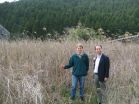(Press-News.org) In the minds of many, Miscanthus x giganteus is the forerunner in the race of viable feedstock options for lignocellulosic bioenergy production. But researchers believe "putting all their eggs in one basket" could be a big mistake. Scientists at the University of Illinois recently reported the first natural occurrence in several decades of Miscanthus hybrid plants in Japan.
"If M. x giganteus is the only variety available, there are certainly risks involved such as diseases or pests causing widespread establishment problems or yield losses," said Ryan Stewart, assistant professor of horticulture in the Department of Crop Sciences at the University of Illinois. "We are trying to find Miscanthus hybrids to increase our options. In doing so, it's a way to hedge our bets."
M. x giganteus is a sterile triploid (three sets of chromosomes) formed by a natural cross of M. sacchariflorus and M. sinensis. Because it's sterile, it can only be propagated by vegetative division, which is somewhat more difficult than propagating by seed, Stewart said.
"Because it's a sterile clone, it's more or less a dead-end for plant breeders because it can't be improved through plant breeding," he said.
Stewart and his team investigated overlapping populations of tetraploid M. sacchariflorus and diploid M. sinensis in Japan in hopes of finding triploid hybrid plants that may be similar in productivity to M. x giganteus. However, finding this occurrence out in the wild is a rare event, he said.
"In Japan, even when two plant species are adjacent to one another, they may have very different flowering times, meaning the likelihood of finding a hybrid is very low," Stewart added.
But Stewart knew that there were certain areas in Japan where M. sacchariflorus and M. sinensis sat side by side and had overlapping flowering times. So, with the help of his colleagues, Aya Nishiwaki of the University of Miyazaki and Toshihiko Yamada of Hokkaido University, they set out to search for these rare Miscanthus hybrids.
Last year, Nishiwaki was surprised to find a M. sacchariflorus plant, which was adjacent to some M. sinensis plants, with heavy seed set. M. sacchariflorus in Japan normally spreads vegetatively rather than through seed. Nishiwaki collected this seed, grew it out, and then used flow cytometry to determine the genome size of each of plants. Genome size can be used to detect hybridization events. In analyzing several seeds, their research revealed three triploid plants, which, based on some preliminary molecular analysis, were confirmed to be hybrids.
Researchers hope these new triploid plants will express phenotypic traits similar to that of the high-yielding M. x giganteus. But if they don't, Stewart said they can still serve as sources of genetic variation that might express resistance to recently identified diseases and pests in the M. x giganteus.
M. x giganteus, the first known natural Miscanthus hybrid, was originally found in Japan and then made its way to Europe where it was initially used as an ornamental grass for estates or large gardens, Stewart said. It's a highly productive grass that's cold-hardy, notably for plants that use C4 photosynthesis, which are mostly found in the subtropics and tropics.
It is a popular candidate for bioenergy production because it can grow up to 15 feet tall, creating more biomass than other varieties of Miscanthus.
Stewart and his team have received funding to continue searching for hybrids and to build up a diverse collection of plants of several native Miscanthus species throughout Japan. This collection will serve as a resource for the Energy Biosciences Institute located in the Institute for Genomic Biology at the U of I. Future research will also address the phylogenetic relationship of these hybrids with other Miscanthus taxa, and also their agronomic potential relative to the commonly cultivated M. x giganteus.
INFORMATION:
Stewart's research was published in the American Journal of Botany. Researchers included Aya Nishiwaki, Shotaro Kuwabara, Hiroya Matuura, Ryo Akashi, Sachi Yamaguchi and Genki Ishigaki of the University of Miyazaki; Aki Mizuguti of the National Institute of Agro-Environmental Sciences; Yo Toma, Tomomi Miyashita and Toshihiko Yamada of Hokkaido University; and Lane Rayburn and Ryan Stewart of the U of I.
New Miscanthus hybrid discovery in Japan could open doors for biofuel industry
2010-12-22
ELSE PRESS RELEASES FROM THIS DATE:
Tumor cells in blood may signal worse prognosis in head and neck cancer patients
2010-12-22
COLUMBUS, Ohio – A new study suggests that the presence of tumor cells in the circulating blood of patients with squamous cell cancer of the head and neck may predict disease recurrence and reduced survival. An increased number of circulating tumor cells (CTCs) also correlates with a worse outcome.
Those are the early findings from an ongoing, prospective study of the prognostic importance of CTCs by a team of researchers at The Ohio State University Comprehensive Cancer Center-Arthur G. James Cancer Hospital and Richard J. Solove Research Institute.
The study is ...
Smoking may worsen pain for cancer patients
2010-12-22
Philadelphia, PA, December 21, 2010 – The relationship between smoking and cancer is well established. In a study published in the January 2011 issue of Pain, researchers report evidence to suggest that cancer patients who continue to smoke despite their diagnosis experience greater pain than nonsmokers. They found that for a wide range of cancer types and for cancers in stages I to IV, smoking was associated with increased pain severity and the extent to which pain interfered with a patient's daily routine.
"To elucidate important relations between pain and smoking among ...
Being good moms couldn't save the woolly mammoth
2010-12-22
VIDEO:
Western Ph.D. student Jessica Metcalfe discusses the reasons why woolly mammoths roaming the Yukon Territories thousands of years ago waited so long to eat plants and how she and her...
Click here for more information.
New research from The University of Western Ontario leads investigators to believe that woolly mammoths living north of the Arctic Circle during the Pleistocene Epoch (approx. 150,000 to 40,000 years ago) began weaning infants up to three years later than ...
Parents favor genetic testing for melanoma in their children
2010-12-22
Salt Lake City, Dec.21, 2010—The vast majority of parents who tested positive for a genetic mutation that increases the risk of melanoma (the most serious form of skin cancer) support genetic testing of their children or grandchildren. Results of the two-year study at Huntsman Cancer Institute (HCI) at the University of Utah (U of U) appear in the December issue of the journal Genetics in Medicine. The data could lead to the establishment of formal, evidence-based guidelines for genetic testing of people younger than 18 years.
The study, led by Sancy A. Leachman, M.D., ...
Top research highlighted in fight against heart disease and stroke
2010-12-22
Research on reducing risks, improving medical treatment and improving lifestyle behaviors to fight the battle against heart disease and stroke are among the key scientific findings that make up this year's top cardiovascular and stroke research recognized by the American Heart Association/American Stroke Association.
The association has been compiling an annual list of the top 10 major advances in heart disease and stroke research since 1996. This year, for the first time, two separate lists have been compiled that highlight the top ten research advances in each respective ...
The universe's most massive stars can form in near isolation, new study finds
2010-12-22
ANN ARBOR, Mich.---New observations by University of Michigan astronomers add weight to the theory that the most massive stars in the universe could form essentially anywhere, including in near isolation; they don't need a large stellar cluster nursery.
This is the most detailed observational study to date of massive stars that appear (from the ground) to be alone. The scientists used the Hubble Space Telescope to zoom in on eight of these giants, which range from 20 to 150 times as massive as the Sun. The stars they looked at are in the Small Magellanic Cloud, a dwarf ...
Seminal papers on election law and election administration
2010-12-22
New Rochelle, NY, December 21, 2010—A festschrift honoring Daniel H. Lowenstein, a pioneering legal scholar, Professor at UCLA School of Law, and Founding Co-Editor of Election Law Journal, who devoted his career to advancing election law and campaign finance reform, highlights the current issue of Election Law Journal, a peer-reviewed publication of Mary Ann Liebert, Inc. The issue is available free online.
"Dan quite literally founded the field of election law," says UCLA School of Law professor and colleague of Lowenstein's, Adam Winkler in his introduction. Winkler ...
Women war veterans face higher risk of mental health problems during pregnancy
2010-12-22
New Rochelle, NY, December 21, 2010—Pregnancy among women veterans who served in Iraq and Afghanistan appears to increase their risk for mental health problems such as depression, anxiety, and post-traumatic stress disorder (PTSD), according to a study published in Journal of Women's Health, a peer-reviewed journal published by Mary Ann Liebert, Inc. The paper is available free online.
The stress associated with military service in a war zone may later contribute to an increased risk of mental health problems if a woman veteran becomes pregnant. Because the hormonal ...
Long-lasting chemicals threaten the environment and human health
2010-12-22
Every hour, an enormous quantity and variety of manmade chemicals, having reached the end of their useful lifespan, flood into wastewater treatment plants. These large-scale processing facilities, however, are designed only to remove nutrients, turbidity and oxygen-depleting human waste, and not the multitude of chemicals put to residential, institutional, commercial and industrial use. So what happens to these chemicals, some of which may be toxic to humans and the environment? Do they get destroyed during wastewater treatment or do they wind up in the environment with ...
CSHL scientists show in unprecedented detail how cortical nerve cells form synapses with neighbors
2010-12-22
Cold Spring Harbor, NY-- Newly published research led by Professor Z. Josh Huang, Ph.D., of Cold Spring Harbor Laboratory (CSHL) sheds important new light on how neurons in the developing brain make connections with one another. This activity, called synapse validation, is at the heart of the process by which neural circuits self-assemble, and is directly implicated in pathology that gives rise to devastating neurodevelopmental disorders including autism and schizophrenia.
In the mammalian brain, even in its early stages of postnatal development, the cortex, the seat ...



